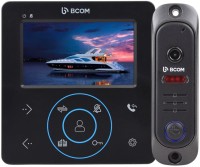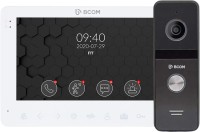Smart Doorbell, Video Intercom, or Smart Lock: What's the Difference and Which One to Choose?
We independently test the products and technologies that we recommend.

1. Smart Doorbells
Smart doorbells are one of the simplest ways to implement an access control system. The smart doorbell cannot unlock locks or block doors, but it does allow you to see visitors, even if no one is home. Besides the usual call button, video doorbells are equipped with a camera, Wi-Fi module, microphone, and speaker. Why is all this needed? Let's figure it out step by step.
So, the built-in camera is the main actor in any smart doorbell. In basic models, it serves as a kind of "peephole" — the video stream is broadcast in real-time from the camera to a linked smartphone. Advanced video doorbell models can record videos on a memory card or directly to the "cloud". Note that footage on cloud servers is usually stored for a short time (on average up to 72 hours), and also, access to the "cloud" will likely require a paid subscription. The video doorbell camera is activated both by pressing the call button and by a motion sensor. The doorbell itself can be set up in such a way that it sends notifications to a mobile app upon button press, detection of movements near the front door, etc.

The connection between a smart doorbell and a conditional smartphone or tablet is often supported by a Wi-Fi network. Therefore, video doorbells highly depend on the availability of wireless Internet access. However, rare instances of smart doorbells with wired connection (via LAN port) do exist — such a means of connection is more typical for classic video intercoms.
As for the microphone and speaker, they serve for two-way communication with visitors without the need to open the door. If there is no one home, unwanted guests can be deterred with a voice message from the smartphone. Moreover, in some smart doorbells, there is a voice-changing function, which can be valuable for children, elderly people, and women who respond to unwanted visitors.

Video doorbells are incredibly easy to install and set up. Users will only need to take care of the regular replacement or recharging of power elements — the vast majority of smart doorbells receive autonomous power supply from batteries or accumulators.
| Main Advantages of Video Doorbells | Main Disadvantages of Video Doorbells |
|---|---|
|
|
2. Video Intercoms
Intercoms provide much more flexibility in terms of access control. Technically, they consist of an outdoor calling block and an internal subscriber panel. These modules are purchased separately or as a single set.
Note that several calling modules (installed, for instance, at the entrance to the adjacent territory and directly at the front doors) can often be connected to the subscriber panel. Moreover, several subscriber panels or monitors can also be connected to one calling block — this way, answering calls from guests will be convenient from any room. In advanced implementations, Intercom communication is established between multiple internal panels.
The "eyes" in video intercoms are built-in cameras in the calling block or separately connectable surveillance cameras. The lion's share of models supports working with two external cameras, in rarer cases, there can be more (3 – 4 pcs., ≥ 5 pcs.). The image from connected cameras is displayed alternately or in the so-called quad format, where the screen of the internal panel is divided into segments for simultaneous viewing from all possible angles.

Perhaps, the main difference between video intercoms and smart doorbells is the presence of a large color display in the structure of the internal (room) block. At the same time, many intercoms support remote unlocking of door locks. This control often takes place through the internal panel, which has a button or touch sensor to activate the lock mechanism. This way, the user can unlock the lock from the screen or control panel without approaching the door.
Usually, intercoms are connected using a wired method (analog or via LAN port). In the case of LAN connection, the internal panel of the intercom can receive PoE power over the same network cable connecting the devices. Wired connection requires installation work – drilling walls, installing mounts, laying the wire, etc. The task is simplified by models with wireless connection via Wi-Fi network, though various radio interference can disrupt their operation.
The functionality of video intercoms is not limited to solely transmitting images from external cameras and enabling two-way audio communication between the blocks of the access system. The outdoor panels of intercoms are often equipped with key-card readers, IR illumination for clear image capture in the dark and even facial recognition systems (in flagship models).

The calling panels of some intercom models can be integrated into remote access systems via a mobile app for smartphones or tablets. This requires active Internet connection and a linked mobile device.
| Main Advantages of Video Intercoms | Main Disadvantages of Video Intercoms |
|---|---|
|
|
3. Smart Locks
Smart locks represent a slightly different format of access control devices. In fact, these are electronic locks that replace or supplement the mechanical door closing system. Smart models are produced both in the form of standalone locks and as overlays on traditional mechanical locks.
Why are these locks called "smart"? It's simple — they can be unlocked and locked via an app on a smartphone, connecting through Bluetooth or Wi-Fi. The mobile program often includes additional tools such as an access schedule (for a cleaning person) or the distribution of virtual keys to other users.
Unlocking a smart lock via a smartphone is the main way to access a premise, yet it's not the only one. The handles of smart locks often incorporate key-card readers, buttons for entering a PIN code, or fingerprint scanners. Facial recognition sensors appear less often, found in flagship models. Unlocking the lock using a PIN code is an optimal option for daily home rentals.

Smart locks should be considered in conjunction with smart doorbells and video intercoms. They work best in combinations like:
- smart doorbell + smart lock — the doorbell records the visit and allows you to see the visitor through a mobile app, then you unlock the lock from the same smartphone;
- video intercom + smart lock — the intercom provides an image, and the smart lock unlocks the door from the subscriber panel (if there is compatible support).
| Main Advantages of Smart Locks | Main Disadvantages of Smart Locks |
|---|---|
|
|
4. What to choose in the end?
| Smart Doorbell | Video Intercom | Smart Lock | |
|---|---|---|---|
| Audio and video communication | + | + | - |
| Lock opening | - | +/- | + |
| Remote access | + | +/- | + |
| Photo and video recording | + | + | - |
| Connection | Wireless | Wired / wireless | Wireless |
To see directly from a smartphone who is at the door, a smart doorbell will suit well.
Receiving images from multiple security cameras, recording visits, and remotely unlocking doors are the prerogatives of video intercoms.
To ensure convenient access to a premise through virtual keys, fingerprints, or via PIN code, a smart lock is suitable.
















































